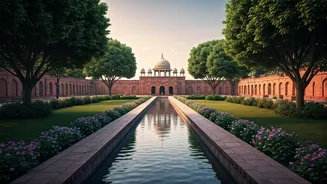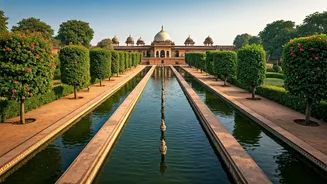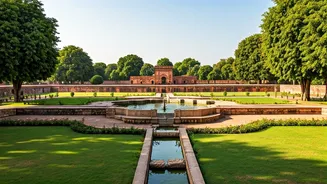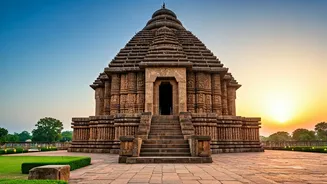Garden Origins
Mughal Gardens represent a unique fusion of Persian, Central Asian, and Indian architectural styles, reflecting the cultural background of the Mughal emperors.
Their establishment signifies a departure from the conventional Indian gardens of the time, emphasizing symmetry, water features, and geometrical layouts. These gardens were not merely aesthetic spaces; they also served important purposes in Mughal life. They were used for relaxation, formal gatherings, and symbolic representations of paradise, reflecting the emperor's power and divine connection. The architectural planning of these gardens typically involved the integration of flowing water, strategically placed fountains, and pathways that were designed to lead the visitor through a carefully curated experience, creating a sense of tranquility and order.
Shalimar Bagh
Located in Srinagar, Kashmir, Shalimar Bagh is a quintessential example of Mughal garden design, constructed by Emperor Jahangir for his wife, Nur Jahan. The garden's design is based on the Persian concept of paradise, featuring cascading terraces, water channels, and pavilions. Its three levels, each with its unique function and design, demonstrate the Mughal focus on aesthetic beauty and spatial organization. The central channel, known as the 'Chini Khanas', features niches with oil lamps, illuminating the water at night to create a magical effect. Today, Shalimar Bagh continues to attract visitors from around the world who come to admire its beauty and learn about its historical context, making it one of the most visited locations in the region.
Nishat Bagh
Also located in Srinagar, Nishat Bagh, meaning 'Garden of Delight,' was designed by Asaf Khan, Nur Jahan's brother. It is known for its exquisite layout, set on the slopes of the Zabarwan range overlooking the Dal Lake. The garden features a series of terraces that offer expansive views of the lake and surrounding mountains. This specific design allows the visitors to take in the panorama from several points as they walk throughout the levels. The use of Persian design is evident in its geometric arrangement, water channels, and carefully planted flowerbeds. The design is intended to highlight the natural beauty of the surroundings while providing a space for serenity and enjoyment. Nishat Bagh is a prime example of the Mughal emperors' appreciation for natural beauty and their knack for seamlessly integrating it with their architectural projects.
Pinjore Garden
Pinjore Garden, also known as Yadavindra Garden, is located in the state of Haryana and is a historical landmark of India. This garden's distinctive feature is its symmetrical layout, which showcases a series of terraces and pavilions. The gardens have several buildings that represent a variety of styles. The design of the garden reflects the formal Persian charbagh layout, with a central water channel and carefully arranged plantings. The terraces also have different pavilions, each with its own purpose, creating a sense of grandeur and providing a space for both public and private functions. This garden's historical significance lies in its role as a place for celebrations and events, allowing a reflection of Mughal influence on the region's culture.
Humayun's Tomb
The garden surrounding Humayun's Tomb in Delhi is a significant example of Mughal garden design. The tomb is surrounded by a vast Charbagh garden, signifying a paradigm shift of the Mughal architecture. The design incorporates a square plan divided into quadrants by pathways and water channels. The design is representative of the Mughal's concept of paradise. The garden's architecture features pathways, water channels, fountains, and trees, all designed to create a sense of harmony and tranquility. This carefully constructed environment enhances the tomb's beauty and importance, making it a masterpiece that still attracts tourists today. It's a key example of the fusion of Persian and Indian architectural styles, representing the Mughal vision and attention to detail.
Taj Mahal Garden
The Taj Mahal in Agra, perhaps the most iconic example of Mughal architecture, is surrounded by a magnificent garden. The design of the garden is also based on the Charbagh layout, with symmetrical pathways, water channels, and reflecting pools. The presence of these elements demonstrates the Mughal vision of creating a space that represents paradise. The strategic arrangement of trees, fountains, and flowers complements the monument's beauty. The Taj Mahal garden's design reflects the Mughal emperors' meticulous planning and their dedication to creating spaces that are both aesthetically pleasing and symbolically significant. The garden perfectly frames the Taj Mahal, adding to its mystique and eternal appeal.
Mehtab Bagh
Located across the Yamuna River from the Taj Mahal in Agra, Mehtab Bagh provides an alternative viewpoint of the iconic monument. Unlike the traditional Charbagh, the garden is designed to function as a moonlit garden, providing a calming experience at night. The design features a square layout with geometric patterns, designed to reflect the Taj Mahal. The planting of different flower varieties, especially during the moonlight, creates a beautiful setting, with a perfect view of the Taj Mahal. The garden’s design and concept showcase a blend of beauty, reflecting the Mughal emperors' appreciation for art, architecture, and a keen attention to detail.
Rambagh Garden
Rambagh Garden, also located in Agra, is often considered one of the earliest Mughal gardens in India. Its construction during the early Mughal period showcases the evolution of garden design under the emperors. The layout of the garden blends Persian and Indian elements, with a formal layout that includes water channels, pathways, and lush greenery. Its serene ambience and well-planned design served as a model for subsequent Mughal gardens. Rambagh is a testament to the Mughal dynasty's architectural and landscape mastery, providing a deep insight into their rich cultural legacy.
Fatehpur Sikri Gardens
Fatehpur Sikri, built by Emperor Akbar, features several gardens. The gardens are an integral part of the complex, and they were designed to create a harmonious environment, enhancing the overall appeal. Each building is complemented by its distinct garden, with water elements, fountains, and detailed landscaping. These gardens are evidence of the Mughal emperors' focus on integrating architecture with nature, creating a sense of peace and harmony within the walled city. The Fatehpur Sikri gardens are unique because they were used for both royal pleasure and the expression of Akbar's religious tolerance. They highlight the rulers' creative planning and attention to detail.
Lodhi Garden
Although not purely a Mughal garden, Lodhi Garden in Delhi reflects many Mughal design influences. It also contains architectural landmarks, including the tombs of Sayyid and Lodi rulers, that were built before the Mughal era. The garden's layout features several water channels and walking paths that weave through the landscape. The gardens are beautifully maintained, creating a peaceful escape within the city. The serene ambiance and historical significance of the garden make it a popular spot for both residents and visitors. Lodhi Garden demonstrates the blend of design influences, reflecting the evolution of gardens in the region and creating a lasting legacy.














